The Insiders Travel Guide: 8 Days in Turkey With Lorinda
Day 1: Cruising the Ancient Bosphorus
Our Turkish journey on this 8-day tour started in the bustling and vibrant city of Istanbul where we were met by our fabulous tour guide Metin, and our amazing driver Matool.
In Istanbul, we all checked in at the beautiful Sirkeci Mansion Hotel and after freshening up we did not let one moment go to waste – we were off on our first adventure – a cruise on the stunning Bosphorous, which is a natural strait connecting the Black Sea to the Sea of Marmara, thus being a very strategic waterway.
In the Turkish language, Bosphorus (Bogazici) means inner strait. Since ancient times this river has held an important role because of its strategic location. It felt really important here. Meanwhile our guide, Metin, regaled us with stories about the luxurious mansions that line the famous waterway. Even Russian President, Putin, has his summer house here!
The Bosphorus runs right through the heart of Istanbul, past the Istanbul Modern Art Museum, several Ottoman palaces, at least two fortresses, forested hills, and shore villages with Ottoman architecture. It’s a truly joyous and interesting cruise!
Day 2: Exploring Gems of Istanbul
After a day on the water, exploring the shores of Istanbul and much-needed restful sleep after, we embarked on a fully guided tour of the city.
Visiting the Blue Mosque, St Sophia Museum, Turkish and Islamic Arts Museum and the Hippodrome, we’ve had our day full of discoveries, beautiful architecture and mind-blowing facts.
The Blue Mosque (or Sultanahmet mosque) is not one of the biggest but it’s one of the most beautiful indeed. It’s called the Blue Mosque because of the blue tiles on the walls – you absolutely must get inside to really appreciate the name of this stunning building.
The Blue Mosque was built between 1609 and 1616, by the architect Mehmet Ağa, instructed by Sultan Ahmed I. It was designed as an imperial show of strength to complement the imposing Hagia Sophia, which faces it across Sultanahmet Square.
Aside from its staggering size and exquisite beauty, one of the most distinctive elements of this Istanbul mosque is that it has six minarets, as opposed to the usual two or four of most of the city’s mosques. In the history of the Blue Mosque, legend has it that this is because of a misunderstanding – when the Sultan decreed there should be altın minare (gold minarets), the architect heard altı minare (six minarets) – an easy mistake to make!
Hagia Sophia is a treasure from the Byzantine and Ottoman Empires. It was once a church, later a mosque, and now a museum.
Hagia Sophia is also called Church of the Holy Wisdom or Church of the Divine Wisdom, cathedral built in Constantinople (now Istanbul, Turkey, of course) in the 6th century CE (532–537) under the direction of the Byzantine emperor Justinian I.
Istanbul Museum of Turkish and Islamic Arts is a treasure-house of beautiful objects from the Ottomans (14th to 20th centuries), Seljuks (11th to 13th centuries), and earlier periods beginning in the 8th century. The Museum, Ottoman palace before, was built in 1524 for İbrahim Paşa, childhood friend, brother-in-law and grand vizier of Süleyman the Magnificent.
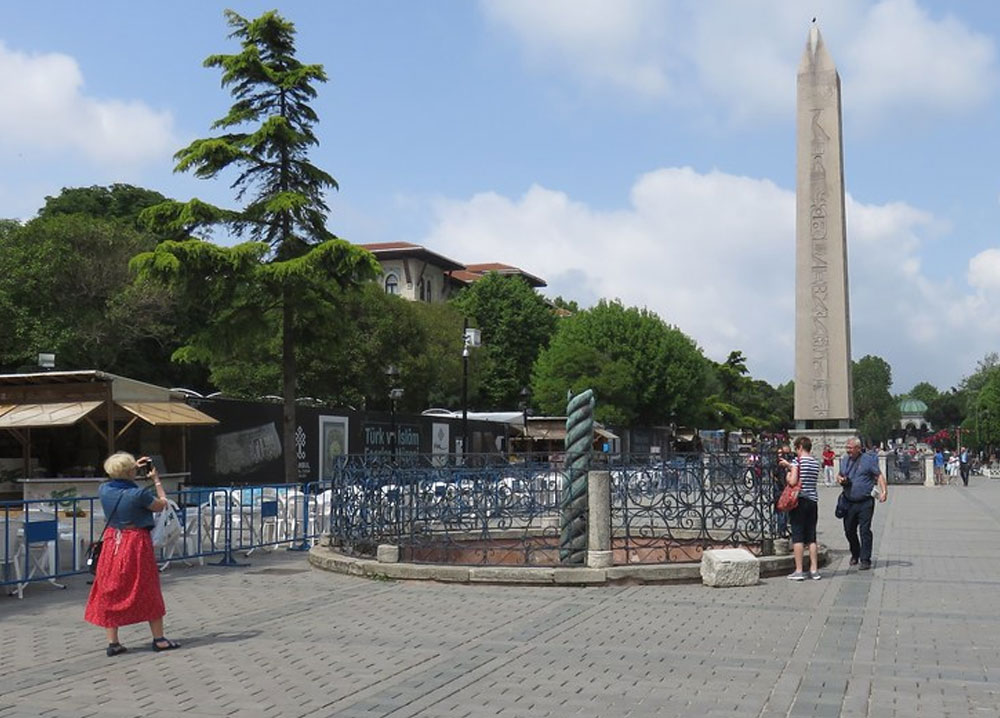
Lastly, we paused to admire the Hippodrome, which was a public arena mainly for chariot races. In its heyday, it was decorated by obelisks and statues, some of which remain in place today. Re-landscaped in more recent years, it is one of the city’s most popular meeting places and promenades.
Our second day in Istanbul was coming to an end, so we headed to the airport to catch a flight to Izmir and upon arrival transferred to Kusadasi.
On board of Turkish Airlines, we were served the most delicious toasty and a hot drink. I am still dreaming of that toasty!
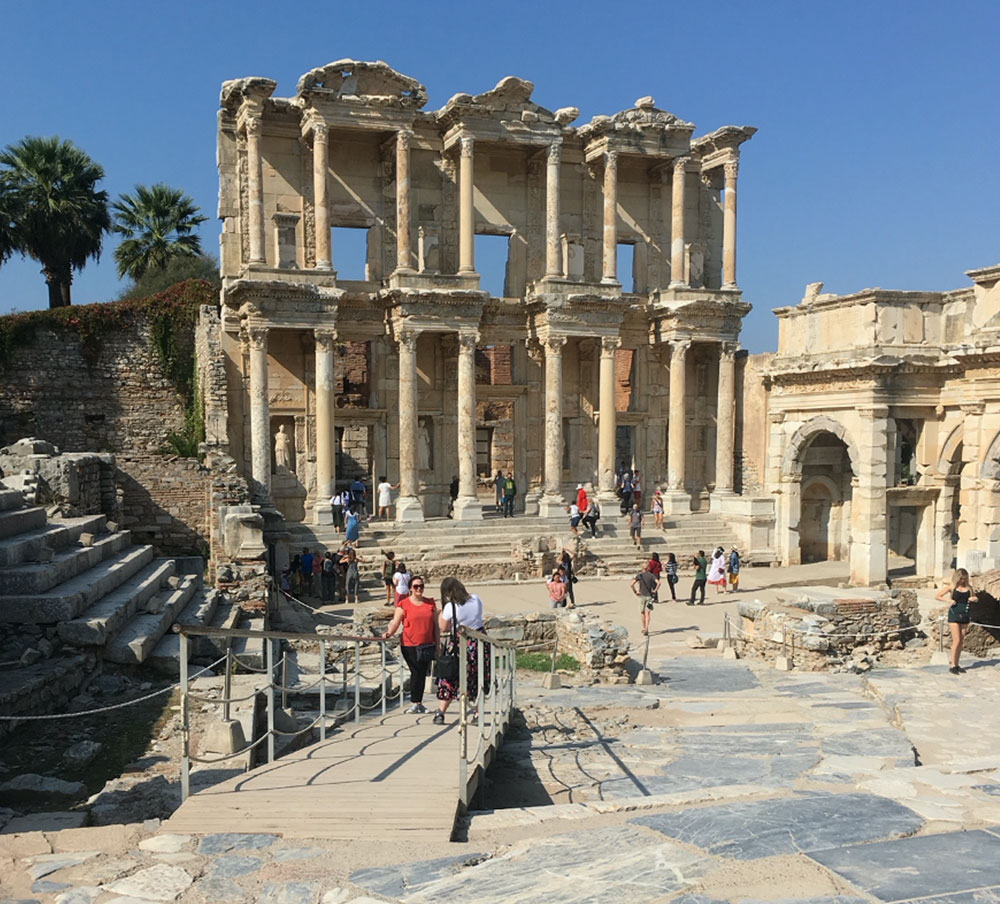
Day 3: Stepping into a Time Machine in Kusadasi
In Kusadasi, we had the pleasure of a guided tour of Ephesus and a visit to the site of the Temple of Artemis. Kuşadası is a popular destination in Turkey and the coastal gateway to Ephesus, Turkey’s busiest cruise port.
Known today as Ephesus, the ancient city is called Ephesos in Greek and Efes in Turkish, dates from the 10th century BC. Take a walk around are Hellenistic and Roman era ruins. Second only in size to Rome, Ephesus was the Roman capital of Asia Minor (modern Turkey).
The Temple of Artemis at Ephesus was double the dimensions of other Greek temples including the Parthenon, that it was soon regarded as one of the Seven Wonders of the ancient world. Destroyed by a deliberate fire in the 4th century BC and then rebuilt, the great Ionic temple survived until late Antiquity and the Gothic invasion of c. 267 CE. Once again rebuilt, in 401 CE it was torn down for the last time by a Christian mob. Today only the foundations and a solitary column stand as a reminder of the site where once stood the greatest temple in the ancient Mediterranean.
Here, you can really feel the mystical atmosphere of the ancient city. Take a moment here to really absorb this.
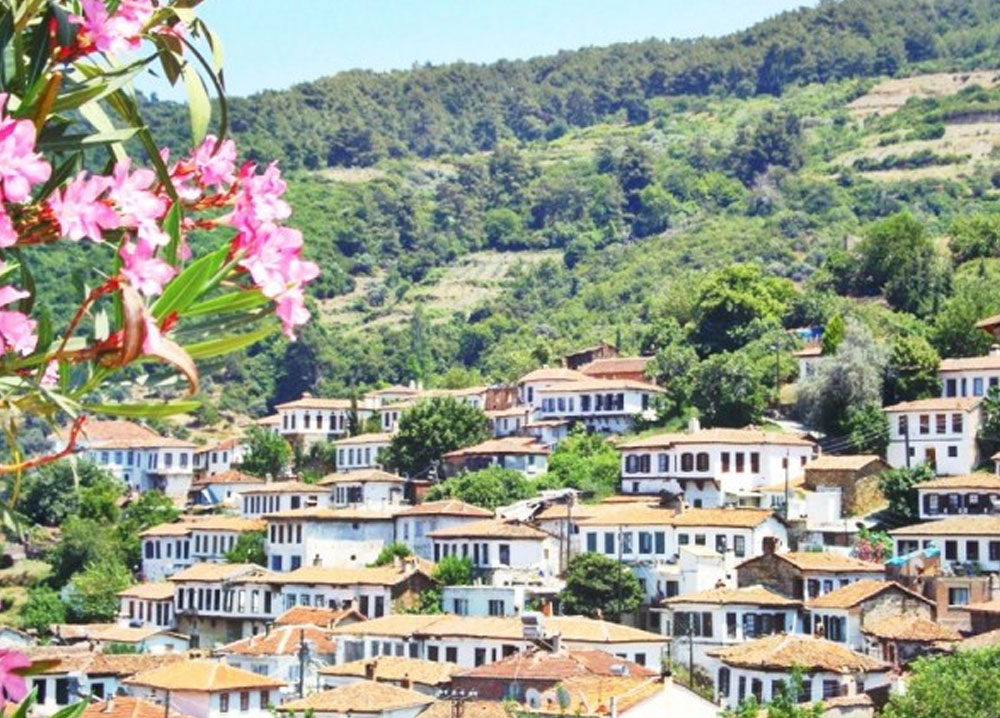
Our next destination is the former Greek village of Sirince, which is famous for its fruit wines. This pretty old Orthodox village, 12 km away from Ephesus and 30 km from Kusadasi, was once known as Cirkince, meaning ugly. The local inhabitants gave this name on purpose to discourage foreign travellers from visiting them, keeping the beauty of their village to themselves.
Today the village is a perfect synthesis of Turk-Greek culture from the 1920’s.
Fun fact: on 21 December, 2012, there were a number of believers around the world who claimed that the Mayan calendar suggested that the apocalypse would begin in the town of Şirince. It wasn’t true, of course. But added an extra spice to this already growing celebrity of Turkey.
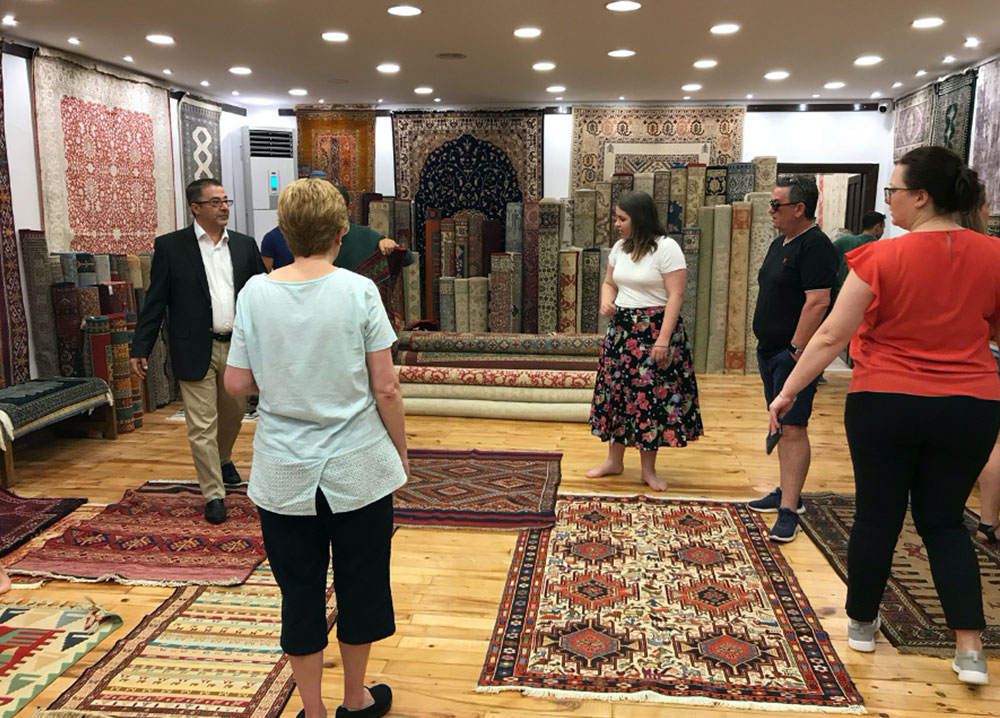
Next stop on our journey was to a local carpet weaving collective.
Carpet weaving has been a long tradition in Turkey. We couldn’t wait to learn more about how Turkish carpets are made, often by hand and what determines their value. I really felt like a little bit of an expert after our visit.
Turks brought their carpet weaving tradition along with them when they migrated from Central Asia toward the West. In their carpet designs, they reflected their own lives as influenced by the climatic and geographic conditions to which they were subjected. They also added influences from their new living conditions and the impact of local cultures, and continued their tradition, albeit with modified colors and designs.
We were treated to a host of drinks, Turkish Coffee, Apple Tea, and the strong Raki. Delicious!
Day 4: Revitalising Day at Pamukkale
Thousands of years ago, the Romans built the city of Hierapolis so their citizens can enjoy the health benefits of the hot mineral water.
Flash forward to today and the city of Pamukkale in Turkey is still one of the healthiest and most mysterious places in the world.
Deep in the earth, beneath the city, lies a vast source of water that is heated by volcanic lava. As a result, the water dissolves pure white calcium, and then becomes saturated with the calcium before appearing on the surface of the earth where it bursts and runs down a steep hillside. As the calcium cools in the open air, the material precipitates from the water and adheres the soil. And the end result is a form of calcium cascades frozen in stone.
On day 4, we headed to Pamukkale to enjoy the calcium terraces (known as Travertines), where we also toured the ancient city of Hierapolis.
Taking a dip, amongst ancient columns, in the hot springs felt magical. I’ve never seen anything so beautiful. And all our aches and pains were cured after a good soak in these healing waters.
We headed back to our hotel to freshen up and grab a quick bite. In Pamukkale we stayed at the Adempira Thermal Hotel (4-star) which is a brand new accommodation here; and it is stunning. At the hotel, they have this amazing spa incorporating natural therapeutic waters. This is where you get to really learn about Turkish bath houses!
Day 5: From The Silk Road Adventure to The Whirling Dervishes Performances
It was the time to travel along the Silk Road, visiting Sultanhani Caravansary and the Mevlana Museum in Konya along the way.
The Silk Road, or as the Turks referred to it, Uzun Yol (Long Road), is an ancient trade route connecting the occident and the orient; running between China and Europe it has been an important conduit of commerce and knowledge since Classical times.
The expansion of the Macedonian Empire under Alexander the Great probably provided the impetus that created the early Silk Road and it was further developed by the Roman and Byzantine Empires.
After our day trip, we all popped in the Elevres Stone House Hotel for a quick freshening up and headed to our Traditional Turkish Folklore evening.
It was a mid-size venue with every single table booked. We tasted traditional Turkish meals with flat bread and dips with unlimited access of delicious drinks, alcoholic and non – alcoholic.
Between the Whirling Dervishes performance and the traditional Belly Dancer, we were mesmerised by the night.
Toward the end of the night we joined the dance floor, trying out various Turkish dance moves.
What a day!
Day 6: Exploring Magical Cappadocia
On day six of our adventure, our trusted driver Matool took us to a truly magical place – the lunar landscape of Cappadocia.
We also visited the Goreme Open-Air Museum and the fairy chimneys, also exploring the many levels of an underground city.
Goreme is a unique ancient cave town where the local communities have lived for centuries. Now, you can also enjoy your own accommodation here, inside a cave. It’s an amazing experience!
Cappadocia in central Turkey Travel Guides Tips is a rocky marvel that was shaped by millions of years of natural phenomena. And now human hands performed equally incredible works here as well. This beautiful place is perhaps most well-known for the panoramic view of hundreds of hot air balloons ebbing and flowing above valleys and volcanic fairy chimney formations – a surreal landscape of carved-out towering rock formations that change colour with every sunset and sunrise.
The Goreme Open-Air Museum is a rocky settlement area that has hosted monastery life between the 4th and 13th centuries. Today, it’s one of the most popular attractions and historic sites in Cappadocia with an audio-tour guiding you through the ancient paintings, churches and cave houses from centuries ago.
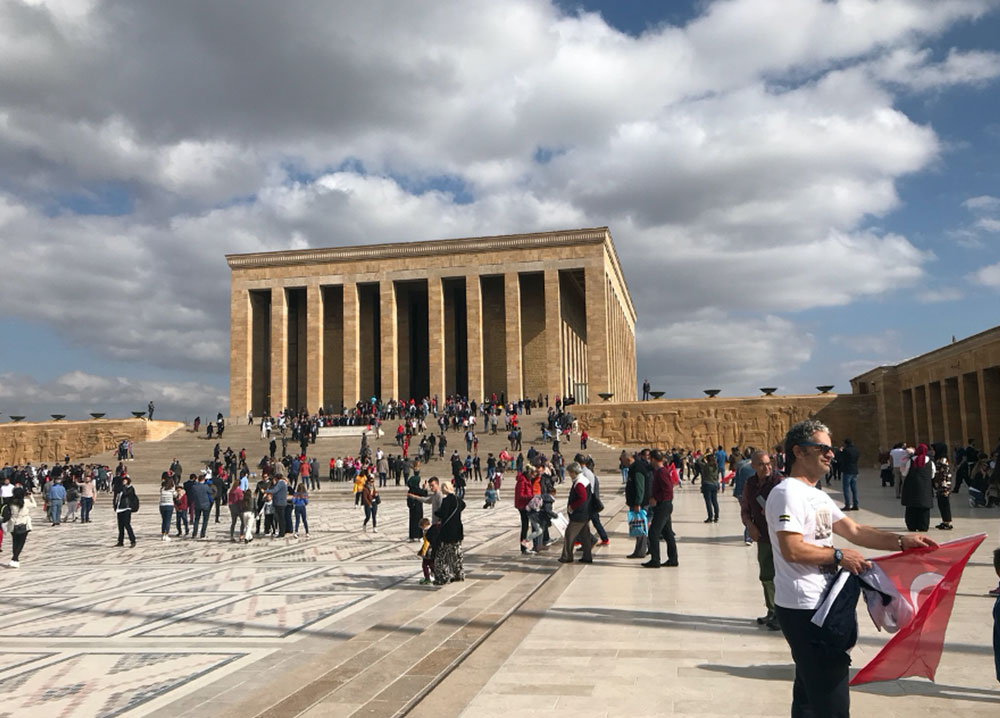
Day 7: Visiting The Capital of Turkey
After a long trip on the road, we arrived to the nation’s capital, Ankara, where we visited the Anit Kabir, mausoleum of the famed Mustafa Kemal Ataturk.
The monumental mausoleum of Mustafa Kemal Atatürk (1881–1938), the founder of modern Turkey, sits high above the city with its abundance of marble. The tomb itself actually makes up only a small part of this complex, which consists of museums and a ceremonial courtyard.
Ankara is Turkey’s beating heart, second largest city, located in the Central Anatolia region and home to the Grand National Assembly of Turkey. This is the hub of many great civilizations with a history dating back to the Stone Age. Famous for its great museums, parks and honey (are you surprised?). We tested some of the local honey on our trip. Be sure to try the local honey ice cream. What a delight!
Day 8: The Egyptian Spice Bazaar Stroll
After a day in Ankara, we travelled back to Istanbul to explore local bustling markets and then start getting ready to travel back home.
The Egyptian Spice Bazaar was everything I had hoped for and more. This is a treasure chest of delicious things – heaps of good deals and easy to get around.
After some time here, we headed to The Grand Bazaar (Kapalıçarşı, meaning Covered Market; also Büyük Çarşı, meaning Grand Market), which is one of the largest and oldest covered markets in the world, with 61 covered streets and over 4,000 shops on a total area of 30,700 m2 – this is a lot of ground to explore.
We got our final shopping in and then it was time to say goodbye.
Call our team of travel planners to discuss your enchanting adventure: 1800 242 353.


















